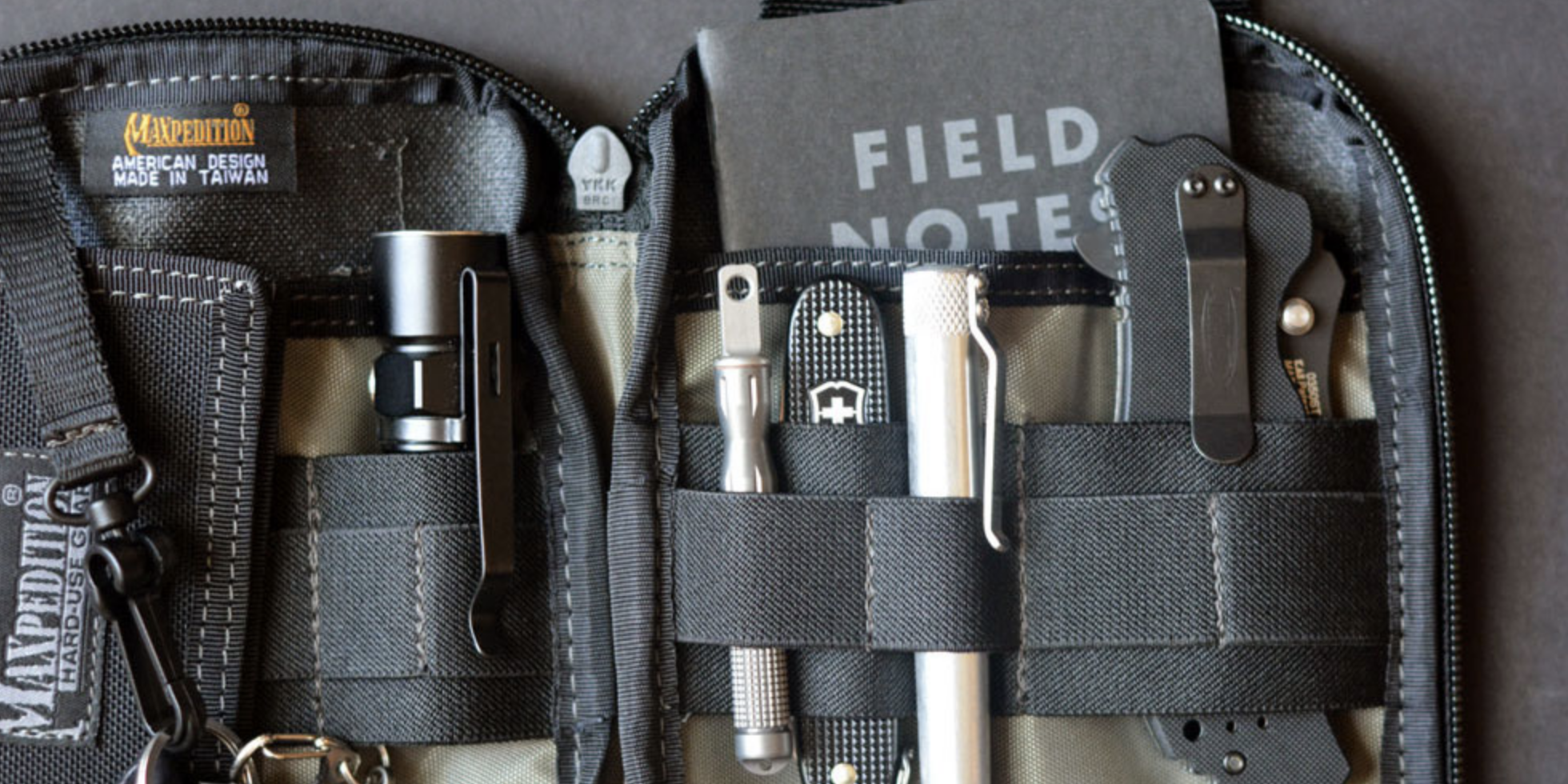The topic of EDC as you’ve never seen it before: without the opinion. We discuss the topic from the ground up, using reasoning and experience.
There are countless articles discussing Everyday Carry (EDC) on the internet. The problem is, there isn’t a realistic threat assessment, or discussion of skill development attached to them. Here, we want to give accurate, actionable, and comprehensive answers to why you should consider developing an EDC.
The following is a list of equipment lines that represent items that will cover, with as much overlap as possible, the widest variety of emergencies. As we dig into the idea of lines of equipment, we will see a strengthening bond between what we’re carrying, our base skills, and how we react to the types of Emergencies outlined in Chapter 1 (if you’re reading the book) or “Understanding Emergencies”.
In short, the lines of equipment we carry roughly align with the type of Emergency. Like the emergencies themselves, equipment will vary between people and there is no one right path for everyone. As such, please consider this a guide to arming yourself against the problems we find in the Rule of Three’s. The lines of equipment are set up to challenge the Reaper when he steps forward to pull you down; develop the skill, and the following tools will help ensure you are able to provide a defense against the hollow-eyed, soul stealer for as long as possible.

As we work through the concepts behind equipment lines, it will be extremely important to sanity check your list. There are some famous pieces of advice that are never taken, and this is some here that I hope you’ll strongly consider:
- Don’t make a list, make a target weight: Use 8% of your body weight as your upper limit.
- A good EDC starts with your clothes. Don’t be the guy wearing flip-flops and shorts when it’s kill-you-cold.You don’t have to dress like an REI catalog on a daily basis, but wear serviceable clothing that offer some protection from the environment.
As to equipment weight, a way to check if your equipment is too heavy is this:
- Do as many pullups as you can while wearing it.
- Climb a fence. Jump a jersey barrier.
- Climb a 10’ wall. If you can do these things, and still hike a few miles – you’re good. This is also a function of your level of fitness, making your physical health the backbone of your ‘everyday carry’.
FIRST LINE – EDC

Purpose:
When discussing our “First Line”, let’s tie this into Understanding Emergencies:
This equipment roughly aligns us with the Type I emergency, and we should break EDC into two categories;
- Routine
- Emergency and Items of Immediate Necessity (IINs)
Routine
The items we carry on a routine basis don’t have to satisfy some survivalist fantasy. Cell phones, thumb drives, lighters multi-tools… all of these are excellent things to have every day, but they’re hard to use if you’re in the midst of an serious emergency. People often skip talking about the “routine” items because they’re not sexy or exciting. Be one of the ones who doesn’t skip it. Not only can the ability to fix things on the fly open doors for interpersonal connections, it can keep you from being inconvenienced. Things like lighters and multitools have periodic, routine uses, and cell phones (while we try not to rely on them) are incredibly powerful time saving devices.
When assembling your “routine” items, consider your skills. What a computer programmer needs is different from what a police officer, or field scientists might need. As you consider their respective place on your person, consider you’ll likely never need to access these things quickly to save a life. For that reason, I keep most of my “routine” items on my non-dominant side. Things like flashlights and cell phones especially. If you train yourself to use them with your support side hand, it’ll make it easier to operate them in conjunction with emergency tools.
Emergency
Emergency equipment is designed to provide us with readily accessible, functional tools for Type 1 Emergencies.
At ISG, we have a distinction between EDC and “Items of Immediate Necessity“, or IINs. There are two general categories of IINs by our thinking:
- Weapons (Knife, Pistol*, Pepper Spray, Taser, Et Cetera)
- Medical Equipment (Tourniquet, NPA, CELOX)

These are the things that you may be called upon to use in a second without prior notice, and are literally life and death tools. You don’t want to have to run to your vehicle to get them, and they should be oriented on your person in such a way that you can get to them quickly. This means situated on your dominant side where they can be accessed quickly.
A final word on our IINs: they don’t have to be perfect. You may be forced to compromise in order to comfortably dress around them. While we want to be as capable as possible, it pays to remain anonymous, as well.
Don’t get caught up with someone telling you that your J-Frame is garbage and you should get a Glock 19 if the choice is between a J-frame on your body or a Glock 19 in your safe. The amount of Kool-Aid going around in the gun world is mind-boggling, so watch who you take advice from. That said, There needs to be a balance between comfort and capability.
*Note: If you’re not comfortable or able to carry a firearm, that’s fine; it’s a small part of the overall preparation, however for our purposes here we will feature weapons as a part of a “complete” EDC envelope.
Discretion
In addition to not drawing unwanted attention, part of our creed is humility. Think carefully of who you want knowing the extent of your skills and equipment.
We also want to be as capable as is possible… with that comes the acceptance that no matter how good we are, death can snatch us away from this world without a moments notice. Ditch the Punisher stickers, the III% and Gadsden Flag decals. They tell everyone personal details about you.
Before we get specific with our EDC/IINs, it’s important to talk about how we carry these things; specifically, do we carry to announce we have EDC, or do we keep it to ourselves?
Certain situations require that our EDC is displayed. Police officers, for example, are a visual presence with their equipment. Their arrangement telegraphs to all around that they are an officer, and have some authority. It’s common to see people carrying knives, multi-tools, and in some states, pistols, openly. While this may be easier to access, think of how it will influence people around you if a Type I (interpersonal violence) emergency were to occur.
Long Story Short: Keep your gear to yourself.
Think of it like Personal Information that you’re not eager to share.
Components:

Now that we’ve established the difference between our Routine EDC and our Emergency IINs, let’s talk about how to carry them. One of the most overlooked items for carrying gear is a solid belt. We don’t care if you use a leather, synthetic, Rigger’s belt, or whatever else, just make sure it’s the right size (typically 1.5″) and it’s not going to allow your equipment to roll on you. If you don’t actually rappel, don’t bother with the Rigger’s belt. If you *do*, get out and use it. It’s very different than a good harness. Especially with equipment carried about your waist.
At this point, let’s break our categories down even further and give an overview of some reasonable things to carry:
Routine

- Multi-tool
- Flashlight
- Folding knife
- Keys
- Cell Phone
- Thumb Drive
- Security/E&E items
Emergency
- Medical pouch (An NPA, CELOX and Rescue Hook fit pretty flat in ITS’s Slimline Medical Pouch)
- Pistol
- Fixed blade knife
- Reload
- Tourniquet
Any combination of these tools is going to increase your usefulness, so start with an assessment of what you bring to the table, what you need to learn, and then give a little thought to what you want to carry and why.
If you’re going to carry a gun or medical equipment: Get training. Medicine is rife with liability. If you want to save lives, learn to do it properly. First Aid/CPR and Bleeding Control are inexpensive and offered everwhere. As to shooting, we don’t care if your uncle’s college roomate had a stepbrother who was in ‘Nam and taught you how to shoot. It doesn’t matter if you’ve been doing it your whole life.
Find a good instructor who understands the intricacies of shootings in the civilian world, and who incorporates Force-on-Force training. It’s all good to get tuned up by some ex-Delta Force guy, but if your judgment is bad, you’ll just make efficient mistakes.
Contact us and we’ll help, if you need us to.
Scaling and Placement
One of the places that we differ from most of the advice you’re going to get is that our lines of equipment are additive. That means we can instantly upgrade our capability by adding our second line. Our Third line adds even more capability, and when done properly, you don’t need to change anything about the items your normally carry.
This principle allows us to scale our gear up or down based on perceived need and situation. As such, we don’t believe in having a “Bug Out Bag” or something like that, and we don’t think you need one either. A backpack should expand your capability to manage the next line of emergencies by providing shelter, water, and some calories, and tools for securing those things. This is discussed in greater detail in our Asset Bag article, but for now, it’s important to consider how you carry your equipment, and if that will allow you to scale up or down with ease.
Placement should likewise be according to need. For example, cell phones, flashlights, and multi-tools don’t need to be immediately accessible with your dominant hand. Because of this, we advocate carrying them on your non-dominant side. Doing this will streamline the processes of extraction, and facilitate things such as low light shooting.
FINAL CONSIDERATIONS
When you consider things to carry on a daily basis, start with a realistic assessment of what you’re capable of.
Get some training, apply that training in the real world, and then adjust to your experiential needs. One of our crusades is to get people to stop buying comfort. In any emergency, a solid balance between skills and sufficient equipment is needed, so don’t neglect one or the other. Also, a disturbing trend has emerged as we’ve found ourselves subject to active shooters and such; police are not coming to save you.
There’s a real reason to believe that you could be the difference between stopping a crisis and saving lives, as well. The FBI said just that, in a recent study.
A well-organized EDC and the skills to drive it might be the difference for you, your family, or those in your community.
Cheers,
ISG Team
A very special thank you to Option Gray for use of the title image. Check him out for his view on EDC options for another perspective!








